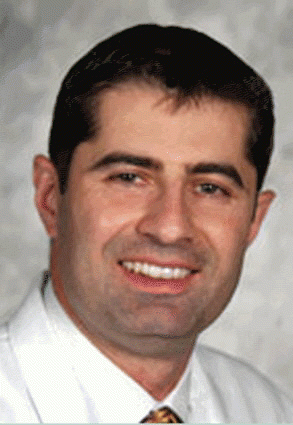Patients who undergo a transnasal esophagoscopy using narrow-band imaging are more likely to have dysplasia diagnosed with a biopsy than those who have the exam using only white light, researchers have reported.
Explore This Issue
December 2008Narrow-band imaging is a great supplement for the screening exam and it may improve the target selection for biopsy to allow for high-yield, specific-targeted biopsy to get pathologic diagnosis of Barrett’s esophagus, said Timothy O’Brien, MD, an otolaryngology resident at the University of Connecticut School of Medicine in Farmington.
In his oral presentation at the 88th annual meeting of the American Broncho-Esophagological Association, conducted as part of the Combined Otolaryngology Spring Meeting, Dr. O’Brien noted a long-time frustration for otolaryngologists: Diagnosing Barrett’s esophagus with a biopsy can be difficult because of poor image clarity during the exams. Studies have shown that the standard upper endoscopy for diagnosing Barrett’s esophagus has a positive predictive value of only 34%, Dr. O’Brien said.
 Our work implies that with proper tools-for example, narrow-band imaging-sensitivity of transnasal esophagoscopy performed in the ENT office may be increased to potentially detect not just Barrett’s, but also dysplastic changes arising in the background of Barrett’s.
Our work implies that with proper tools-for example, narrow-band imaging-sensitivity of transnasal esophagoscopy performed in the ENT office may be increased to potentially detect not just Barrett’s, but also dysplastic changes arising in the background of Barrett’s.-Kourosh Parham, MD, PhD
This is not a new problem, he said. They have seen incongruence for many years. Why is this? Is this because there’s a hit-or-miss nature of the biopsies?
The intestinal metaplasia or dysplasia in the segment with Barrett’s esophagus may be focal or patchy and may not be clearly seen during the exam, he said, making it difficult to get adequate biopsies.
Why Is Narrow-Band Imaging Better?
Enter narrow-band imaging. The technology takes advantage of the penetration and scattering qualities of certain wavelengths of light to produce clearer pictures of the affected areas.
It’s very sharp and crisp and clear, Dr. O’Brien said. In his study, under the supervision of Kourosh Parham, MD, PhD, Dr. O’Brien conducted chart reviews of 111 patients with laryngopharyngeal reflux. They had all been examined by Dr. Parham from 2005 to 2007.
The pictures he displayed were telling. Images from the exam using only white light showed the affected area with not much contrast to the area around it.
In the narrow-band imaging pictures, however, the reddened affected area is surrounded by a white area, giving a contrast vital in the exam.
On 58 of the patients in the study, the transnasal esophagoscopy was conducted using only white light. On the other 53, the exam was conducted using narrow-band imaging.
Biopsies showed three of the patients to have dysplasia. All three of the patients had been examined using narrow-band imaging. These numbers were significant (p = 0.03), although there was a small sample size of patients, Dr. O’Brien said.
Biopsies showed 15 of the patients to have Barrett’s esophagus-eight of the patients who had been examined using narrow-band imaging and seven of those examined using only white light. That breaks down to 15.1% with narrow-band imaging and 12.1% with white light only.
This was not approaching statistical significance (p = 0.32), Dr. O’Brien said.
Orangeburg, NY-based Olympus Surgical America provided the narrow-band imaging system for the study.
Road to Better Diagnosis
Better diagnosis of patients with laryngopharyngeal reflux could have broad implications, Dr. O’Brien said. And more widespread, and more effective, use of transnasal esophagoscopy is a big part of that, he suggested.
Transnasal esophagoscopy is becoming an increasingly common tool used in our field of otolaryngology, he said. It has been suggested that there is a greater correlation between the symptoms of LPR with the presence of adenocarcinoma than between traditional GERD symptoms with adenocarcinoma.
His study, which is due to appear in Annals of Otology, Rhinology & Laryngology, shows that narrow-band imaging may play a central role in advancements to be made in those critical examinations, Dr. O’Brien said. It allows for greater image clarity, he said. Transnasal esophagoscopy with narrow-band imaging is feasible.
Dr. Parham said that more research should be conducted on the usefulness of narrow-band imaging in esophagoscopy.
Our work implies that with proper tools-for example, narrow-band imaging-sensitivity of transnasal esophagoscopy performed in the ENT office may be increased to potentially detect not just Barrett’s, but also dysplastic changes arising in the background of Barrett’s, he said. Since this study was conducted without true controls, further investigations that involve randomization, patients with known Barrett’s, control group, and blinded endoscopists will serve to verify our findings and further evaluate the utility of narrow-band imaging integrated into transnasal esophagoscopy.
©2008 The Triological Society
Leave a Reply